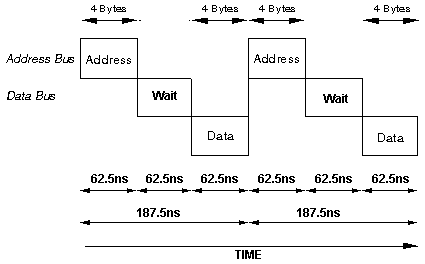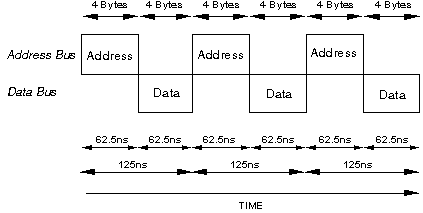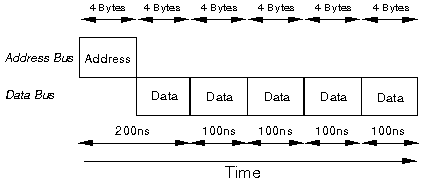|
Basic Matched Memory Matched Memory w/o Wait Streaming Data Transfers 32 or 16 bit Streaming 64-bit Streaming 64-bit Streaming w/50ns Cycle Basic Data Transfer Cycle The basic transfer cycle works by first defining the address (in memory or I/O space) where a transfer is to occur, and then, in a second operation of equal length actually transferring the data. Each half of the operation (defining the address and data transfer) takes 100ns, or 200ns total. This process is repeated until the entire block of data has been transferred. Micro Channel - Basic Data Transfer (20MBps) shows basic data transfer in operation. Basic data transfer on the Micro Channel runs at 20MBps (each cycle takes 200 nanoseconds, and 32 bits or 4 bytes of data are transferred at a time). Five such “default” cycles can be performed in a millionth of a second. Each cycle moves four or two bytes per transfer, yielding a data transfer rate of 20MB/sec for 32-bit (4 byte) transfers or 10MB/s for 16-bit (2 byte) transfers. Basic Data Transfer 20MB/sec for
32-bit transfers or 10MB/s for 16-bit transfers
Matched Memory
Cycle
Matched Memory Cycle
MM cycle without Wait
State
Matched Memory without Wait State
Streaming-Data Transfers In Sep 1989, IBM announced three new procedures for higher data transfer rates- 40MB/s, 80MB/s, and 160MB/s. The 80MB/sec streaming-data rate can be obtained with existing hardware (as of 1991!). Streaming data is only effective for applications that transfer large amounts of sequentially arranged data. However, in many cases, blocks transferred to and from memory are stored in sequential addresses, so repeatedly sending the address for each 4 bytes is unnecessary. With data streaming transfer the initial address is sent, then the blocks of data are sent and it is then assumed that the data requests are sequential. Micro Channel - Data Streaming Transfer (40MBps) shows 40MBps data streaming in operation. The actual data transfer rate achieved is a function of the total burst (packet) length, where the overhead (arbitration process and the address designation of the burst) is “amortized” over a large amount of data. Applications that can benefit include high speed LAN adapters (FDDI), storage devices (SCSI adapters, DASD), and channel-attached memory (memory cards). NOTE: 80 and 160MB/sec streaming is only available on machines / adapters that have dual-path bus capabilities. Both adapters / devices must support streaming. 32-bit or 16-bit
Streaming
32 or 16 Bit Streaming 40MB/sec
for 32-bit transfers or 20MB/s for 16-bit transfers
64-bit Streaming
64-Bit Streaming 80MB/sec
for 32-bit transfers
64-bit
Streaming with 50ns cycle
64-Bit Streaming with 50ns Cycle
|





